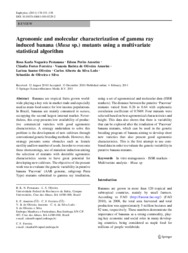Agronomic and molecular characterization of gamma ray induced banana (Musa sp.) mutants using a multivariate statistical algorithm.
Agronomic and molecular characterization of gamma ray induced banana (Musa sp.) mutants using a multivariate statistical algorithm.
Author(s): PESTANANA, R. K. N.; AMORIM, E. P.; FERREIRA, C. F.; AMORIM, V. B. de O.; OLIVEIRA, L. S.; LEDO, C. A. da S.; SILVA, S. de O. e.
Summary: Bananas are tropical fruits grown world-wide playing a key role in market trade and especially used as main food source for low income populations. In Brazil, bananas are mainly consumed in natura, occupying the second largest internal market. Nevertheless, this crop presents low availability of productive commercial varieties with good agronomic characteristics. A strategy undertaken to solve this problem is the development of new cultivars through conventional genetic breeding methods. However, this strategy presents some obstacles such as female sterility and low number of seeds. In order to overcome these shortcomings, use of mutation induction aiming the selection of mutants with desirable agronomic characteristics seems to have great potential for developing new cultivars. The objective of the present work was to evaluate the genetic variability in putative banana Pacovan (AAB genome, subgroup Prata Type) mutants submitted to gamma ray irradiation, using a set of agronomical and molecular data (ISSR markers). The distance between the putative Pacovan mutants varied from 0.26 to 0.64 with cophenetic correlation coef?cient of 0.7669. Four mutants were selected based on best agronomical characteristics and height. This data also shows that there is variability that can be explored after the irradiation of Pacovan banana mutants, which can be used in the genetic breeding program of banana aiming to develop short new varieties that also present good agronomic characteristics. This is the first attempt to use combined data in order to evaluate the genetic variability in putative banana mutants.
Publication year: 2011
Types of publication: Journal article
Unit: Embrapa Cassava & Fruits
Keywords: Banana, ISSR markers, Multivariante analysis, Musa sp
Observation
Some of Embrapa's publications are published as ePub files. To read them, use or download one of the following free software options to your computer or mobile device. Android: Google Play Books; IOS: iBooks; Windows and Linux: Calibre.
Access other publications
Access the Agricultural Research Database (BDPA) to consult Embrapa's full library collection and records.
Visit Embrapa Bookstore to purchase books and other publications sold by Embrapa.

